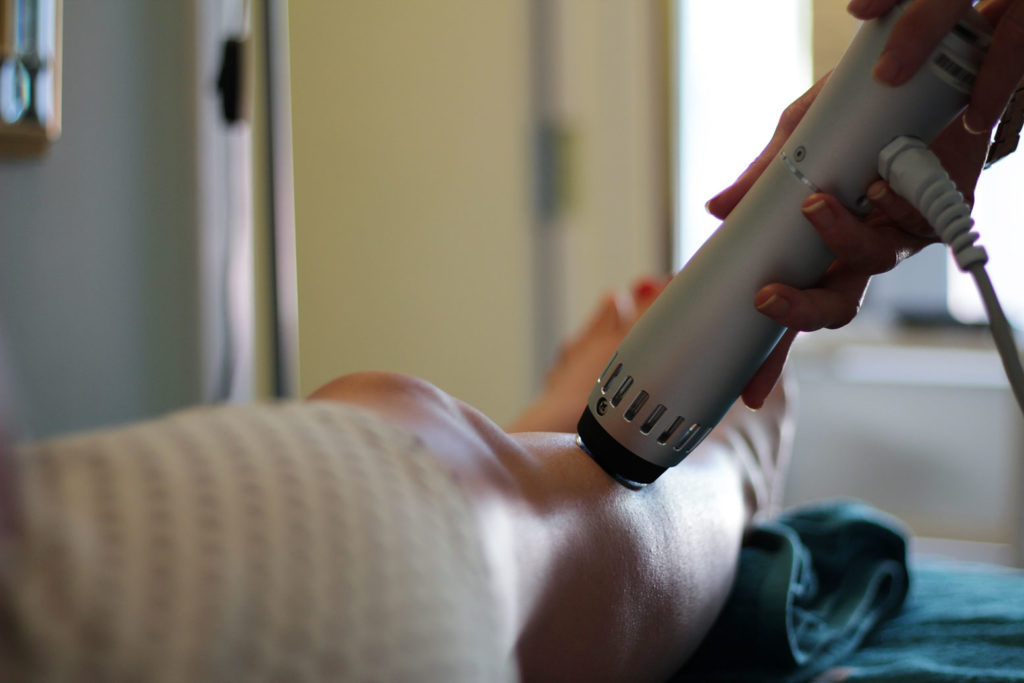Matthew Dilnot
The Melbourne Foot Clinic offers shockwave therapy as an additional treatment option for patients. For those who aren’t familiar with shockwave therapy, I often liken it to patients as “strong” ultrasound. Many people are familiar with the use of ultrasound in physiotherapy practices and may have received this sort of treatment in the past. Shockwave is used in practice similarly to ultrasound; it is an electro mechanical device that is applied against the skin with gel to improve conductance of the pressure waves and reduce friction against the skin. Shockwave is also applied for a similar duration of 3-4 minutes. However, it is measured in number of shocks, the frequency of the shocks, and the force of the shocks.
Types of shockwave therapy
There are two types of shockwave therapy, the most common type being extra-corporeal shockwave therapy (ESWT), which uses pressurised air to create the shockwaves. The other type of shockwave therapy is called focused shockwave therapy (FSWT). Currently here at Melbourne Foot Clinic, we are offering ESWT.
What does it feel like?
Shockwave therapy can be used in varying levels of strength. On the lowest level it feels like light tapping on the skin, but at the highest levels when placed over bony areas it resembles a strong knocking sensation. Often, we start patients at lower levels to familiarise them to the feeling and increase the intensity over time as we treat to their level of tolerance. Generally, the higher the force is applied, the more relief from pain is experienced in the next 24-48 hours as well as more stimulation of repair to the area. Another way to think of shockwave therapy is like a very precise, firm massage.
What is it used for?
We use ESWT for a variety of musculoskeletal conditions including plantar fasciitis, achilles, and calf problems. Very rarely do we use it as an isolated treatment – typically it is used in addition to other methods. With plantar fasciitis for example, we are likely to include shoe changes, activity modification, strapping, stretching, strengthening, and massage. Sometimes cortisone and orthoses are used for difficult cases. This means that we are likely to get a much faster and more reliable response to treatment rather than putting all our eggs into one basket, so to speak. Most conditions are multi-factorial in nature (result of weight gain, foot mechanics, shoe related, activity related, or all the above), therefore, we take a wider view of treatment rather than utilising just one method.
How does it work?
Shockwave therapy is said to work by inducing microtrauma to the tissue where treatment is directed, and this microtrauma initiates a healing response by the body. The healing response causes blood vessel formation and increased delivery of nutrients to the affected area. The microtrauma is also said to stimulate a repair process and relieve symptoms of pain.
How many treatments do I need?
Generally, blocks of three treatments are given at weekly intervals. Often, we will combine this with a review of your symptom progress as well as revision of strapping, orthoses, etc.
How long does it take to work?
People often get a reduction of pain in the first 24-48 hours, but the long-term effects of shockwave are not believed to occur for up to 3 months. So, it works as both a short term as well as a long-term treatment. Hence, it is not an ideal treatment to rely on for those who wish to have significant pain relief within a few weeks, and should therefore be used in conjunction with other therapies.
How much does it cost?
Shockwave is sometimes advertised as a treatment on its own, which, I would imagine, is because it has traditionally been an expensive treatment. Therefore, it has been hard to justify patients paying for this treatment in addition to lots of other treatment modalities. In recent times the costs of these machines are now in the thousands rather than the tens of thousands they used to be. We are able to include shockwave in our consultations for a small additional cost of $20, whilst also providing the usual range of other treatment options.
If you enjoyed reading this post, consider reading our piece about reducing our risk of falling as we age.
